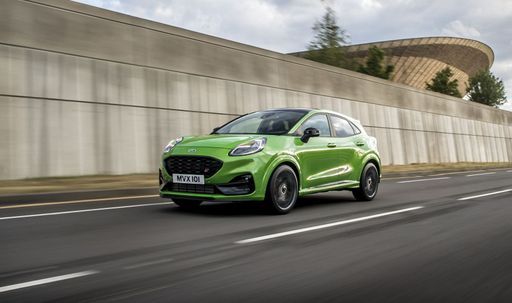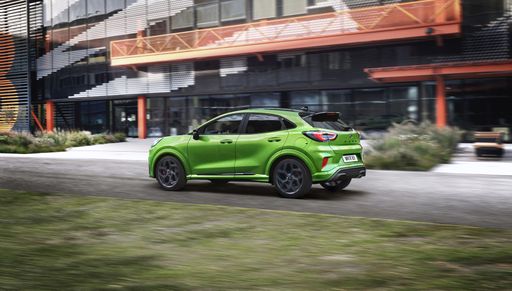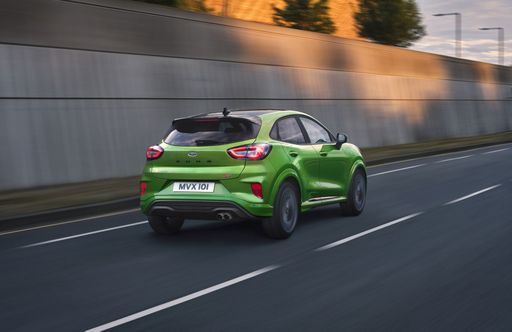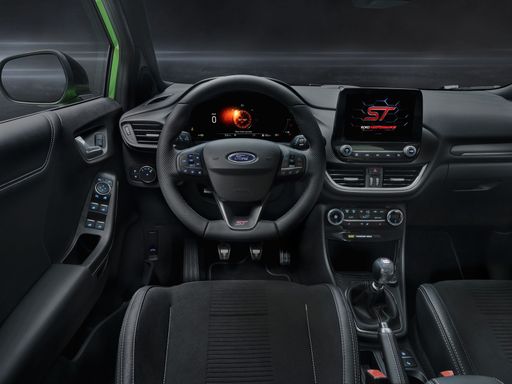Ford Puma vs Kia PV5 - Unterschiede & Preise im Vergleich
Vergleiche Leistung, Kofferraum, Verbrauch und Preis auf einen Blick.
Finde jetzt heraus, welches Auto für dich die bessere Wahl ist, Ford Puma oder Kia PV5?
Der Ford Puma (SUV) kommt mit einem Benzin MHEV oder Elektro-Motor und Manuel oder Automatik Getriebe. Im Vergleich dazu ist der Kia PV5 (Transporter oder Bus) mit einem Elektro-Motor und Automatik Getriebe ausgestattet.
Beim Kofferraumvolumen bietet der Ford Puma 523 L und der Kia PV5 1320 L – je nachdem, wie viel Platz du brauchst. Wer mehr Leistung sucht, muss wählen ob die 168 PS des Ford Puma oder die 163 PS des Kia PV5 für die eigenen Bedürfnisse genügen.
Beim Verbrauch liegen die Werte bei 13.10 kWh5.40 L pro 100 km für den Ford Puma und 19.80 kWh für den Kia PV5.
Preislich startet der Ford Puma ab 28900 €, während der Kia PV5 ab 38300 € erhältlich ist. Vergleiche alle Details und finde heraus, welches Modell besser zu deinem Leben passt!
Ford Puma
Der Ford Puma beeindruckt mit seinem dynamischen Design und sportlichen Charakter, der sofort ins Auge fällt. Im Innenraum glänzt er mit einem modernen Interieur, das sowohl Komfort als auch innovative Technologien bietet. Das Fahrverhalten überzeugt durch eine perfekte Balance aus Agilität und Fahrspaß, ideal für den urbanen sowie ländlichen Raum.
Details @ puma.fordpresskits.com
@ puma.fordpresskits.com
 @ puma.fordpresskits.com
@ puma.fordpresskits.com
 @ puma.fordpresskits.com
@ puma.fordpresskits.com
 @ puma.fordpresskits.com
@ puma.fordpresskits.com
Kia PV5
The Kia EV5 is an exciting new entrant in the landscape of electric SUVs, promising a blend of style and innovation that captures attention. It boasts a sleek and modern design that aligns with Kia's evolving aesthetic identity, blending practicality with eye-catching details. With its foray into the electric vehicle segment, the EV5 is set to offer a highly competitive option for those looking to embrace sustainable mobility without compromising on comfort or tech features.
Details

|
|
|
|
|
Kosten und Verbrauch |
|
|---|---|
|
Preis
28900 - 42400 €
|
Preis
38300 - 45400 €
|
|
Verbrauch L/100km
5.4 - 6 L
|
Verbrauch L/100km
-
|
|
Verbrauch kWh/100km
13.1 - 13.7 kWh
|
Verbrauch kWh/100km
19.8 - 20.3 kWh
|
|
Elektrische Reichweite
364 - 376 km
|
Elektrische Reichweite
288 - 400 km
|
|
Batteriekapazität
43 kWh
|
Batteriekapazität
51.5 - 71.2 kWh
|
|
co2
0 - 136 g/km
|
co2
0 g/km
|
|
Tankgröße
42 L
|
Tankgröße
-
|
Maße und Karosserie |
|
|---|---|
|
Karosserie
SUV
|
Karosserie
Transporter, Bus
|
|
Sitze
5
|
Sitze
2 - 5
|
|
Türen
5
|
Türen
4 - 5
|
|
Leergewicht
1316 - 1563 kg
|
Leergewicht
1860 - 2145 kg
|
|
Kofferraum
456 - 523 L
|
Kofferraum
1320 L
|
|
Länge
4186 - 4226 mm
|
Länge
4695 mm
|
|
Breite
1805 mm
|
Breite
1850 - 1895 mm
|
|
Höhe
1550 - 1555 mm
|
Höhe
1923 mm
|
|
Zuladung
367 - 469 kg
|
Zuladung
505 - 790 kg
|
Motor und Leistung |
|
|---|---|
|
Motorart
Benzin MHEV, Elektro
|
Motorart
Elektro
|
|
Getriebe
Manuel, Automatik
|
Getriebe
Automatik
|
|
Getriebe Detail
Schaltgetriebe, Automat. Schaltgetriebe (Doppelkupplung), Reduktionsgetriebe
|
Getriebe Detail
Reduktionsgetriebe
|
|
Antriebsart
Frontantrieb
|
Antriebsart
Frontantrieb
|
|
Leistung PS
125 - 168 PS
|
Leistung PS
121 - 163 PS
|
|
Beschleunigung 0-100km/h
7.4 - 9.8 s
|
Beschleunigung 0-100km/h
10.7 - 16.3 s
|
|
max. Geschwindigkeit
160 - 210 km/h
|
max. Geschwindigkeit
135 km/h
|
|
Drehmoment
170 - 290 Nm
|
Drehmoment
250 Nm
|
|
Anzahl Zylinder
3
|
Anzahl Zylinder
-
|
|
Leistung kW
92 - 124 kW
|
Leistung kW
89 - 120 kW
|
|
Hubraum
999 cm3
|
Hubraum
-
|
Allgemein |
|
|---|---|
|
Modelljahr
2024 - 2025
|
Modelljahr
2025
|
|
CO2-Effizienzklasse
D, E, A
|
CO2-Effizienzklasse
A
|
|
Marke
Ford
|
Marke
Kia
|
Ford Puma
Einleitung: Der Ford Puma – Mehr als nur ein kompaktes SUV
Der Ford Puma hat sich seit seiner Wiedergeburt als kompakter SUV zu einem beliebten Modell in der Ford-Familie entwickelt. Mit seinem ansprechenden Design, einer breiten Modellpalette und innovativen Technologien bietet der Ford Puma eine attraktive Mischung aus Leistung, Effizienz und Komfort. In diesem Beitrag werfen wir einen genaueren Blick auf die technischen Details und Innovationen, die dieses Fahrzeug auszeichnen.
Motoren: Effiziente Leistung durch Mild-Hybrid-Technologie
Der Ford Puma ist mit einer Reihe von Benzin-Mild-Hybrid-Motoren erhältlich, die sowohl Effizienz als auch Leistung bieten. Die 1.0 EcoBoost-Motoren kombinieren eine beeindruckende Power von bis zu 155 PS mit einem moderaten Treibstoffverbrauch, der zwischen 5,4 und 5,7 Litern pro 100 Kilometer liegt. Diese Motoren sind mit einem 48-Volt-Mild-Hybridsystem ausgestattet, das die Energierückgewinnung beim Bremsen optimiert und die Effizienz weiter steigert.
Getriebevariationen: Manuell oder Automatisch für jeden Fahrstil
Für den Ford Puma stehen sowohl manuelle Schaltgetriebe als auch das fortschrittliche Doppelkupplungs-Automatikgetriebe PowerShift zur Auswahl. Beide Optionen bieten ein dynamisches Fahrerlebnis, wobei das manuelle Getriebe insbesondere bei sportlicher Fahrweise überzeugt und das Automatikgetriebe für eine komfortablere und reibungslosere Fahrt sorgt.
Design und Ausstattung: Stil und Funktionalität im Einklang
Das Design des Ford Puma vereint sportliche Eleganz mit funktionalem Raumangebot. Die klare Linienführung und die markante Frontpartie unterstreichen den dynamischen Charakter des Fahrzeugs. Innen erwartet den Fahrer ein geräumiges Interieur mit einer variablen Kofferraumkapazität von 456 Litern, die durch die innovative "Ford MegaBox" aufgestockt werden kann. Je nach gewählter Ausstattungslinie, von Titanium bis ST-Line Vignale, können Fahrer von einer Vielzahl von Ausstattungsmerkmalen profitieren.
Technologie und Innovation: Fahrerassistenzsysteme auf Top-Niveau
Der Ford Puma ist mit einer Vielzahl moderner Fahrerassistenzsysteme ausgestattet. Zu den Highlights zählen adaptive Geschwindigkeitsregelung, Fahrspurhalteassistent und ein intelligenter Geschwindigkeitsbegrenzer. Darüber hinaus bietet das Modell ein fortschrittliches Infotainmentsystem mit nahtloser Smartphone-Integration, das für Unterhaltung und Information während der Fahrt sorgt.
Sicherheit: Die Priorität im Fokus
Im Bereich der Sicherheit geht Ford keine Kompromisse ein. Der Puma kommt serienmäßig mit einem umfassenden Paket an Sicherheitstechnologien, darunter ein Pre-Collision-Assistent, Fußgängererkennung und eine Rückfahrkamera, die das Einparken in dichtbebauten städtischen Gebieten erleichtert.
Fazit: Der Ford Puma – Ein vielseitiges Fahrzeug für jeden Bedarf
Mit seiner Kombination aus Effizienz, Leistung, modernster Technologie und ansprechendem Design ist der Ford Puma eine hervorragende Wahl für Fahrer, die ein kompaktes, aber vielseitiges SUV suchen. Die Bandbreite an Optionen und Ausstattungsmerkmalen ermöglicht es, das Fahrzeug individuell auf persönliche Vorlieben und Fahrgewohnheiten abzustimmen.
Kia PV5
A Fresh Perspective on Cargo Vans: The Kia PV5
The Kia PV5 stands as a beacon of innovation in the realm of electric cargo vans. Known for its forward-thinking design and practicality, this model sets a new standard in its class. The PV5 combines cutting-edge technology with an eco-friendly design, redefining the expectations for businesses seeking sustainable transportation solutions.
Electric Power Meets Efficiency
At the heart of the Kia PV5 lies an advanced electric powertrain. The model is equipped with a 51.5 kWh battery, offering an impressive electric range of 291 km on a single charge. This robust power supply pairs with a front-wheel-drive system powered by an electric motor that delivers 121 HP (equivalent to 89 kW), keeping the operations both smooth and efficient.
Sustainability Without Compromise
The commitment to sustainability is evident in the PV5’s zero emissions, with a CO2 output of 0 g/km. The van maintains a CO2 Efficiency Class of A, clearly demonstrating Kia’s dedication to reducing the environmental impact of its vehicles. Businesses adopting the PV5 can confidently promote their green credentials while benefiting from the cost savings associated with electric driving.
Designed for Modern Business Needs
The Kia PV5 Cargo L2H1 Electric Automatic model is engineered for functionality and ease of use. Its spacious design accommodates two seats and offers a generous cargo area, making it perfect for diverse delivery needs. The van spans 4695 mm in length, 1850 mm in width, and 1923 mm in height, providing ample space to maneuver goods with ease.
Performance and Practicality
In terms of performance, the PV5 boasts a torque of 250 Nm and can accelerate from 0 to 100 km/h in 16.3 seconds. While its top speed is capped at 135 km/h, this is more than sufficient for urban and suburban delivery routes. The reduction gearbox ensures smooth transitions as it navigates through daily tasks.
Safety and Innovation
Safety is not compromised with the Kia PV5. It features a suite of safety technologies that support the driver in maintaining control and avoiding incidents. These innovations not only contribute to the safety of the driver and cargo but also offer peace of mind to businesses that prioritize the wellbeing of their workforce and goods.
The Road Ahead for Kia PV5
As the automotive industry continues to move towards electrification, the Kia PV5 exemplifies how cargo vans can adapt to this change seamlessly. It represents an essential step towards more sustainable business operations, providing a viable and efficient option for companies looking to reduce their carbon footprint while enhancing operational efficiency. The Kia PV5 is more than just a vehicle; it’s a strategic asset for any forward-thinking business.
Die angezeigten Preise und Daten sind Schätzungen, die auf deutschen Listenpreisen basieren, und können je nach Land variieren. Diese Informationen sind rechtlich nicht bindend.
